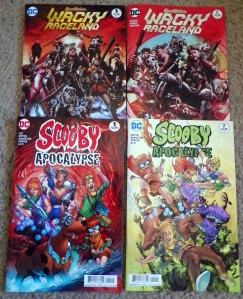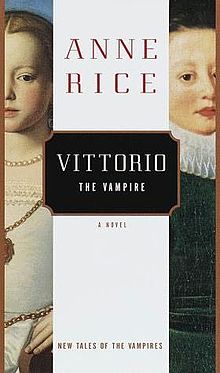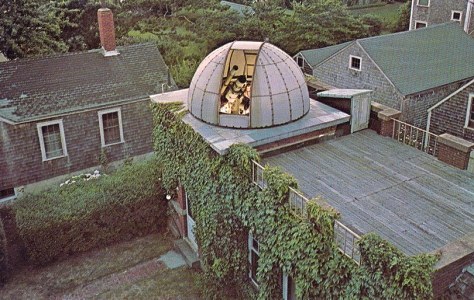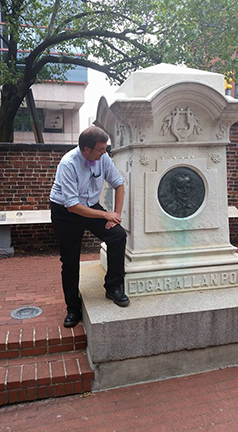While in Tucson recently, I stopped off at a comic shop to see what’s new. As I browsed the shelves, my eyes fell on the title Scooby Apocalypse. The premise is that the familiar gang of Scooby, Shaggy, Velma, Daphne, and Fred are on the scene as nanites are released, transforming humanity in monsters and unleashing worldwide catastrophe.  I browsed through the first issue and saw lovely artwork and soon realized they had created a science fictional reason for Scooby to be able to talk.
I browsed through the first issue and saw lovely artwork and soon realized they had created a science fictional reason for Scooby to be able to talk.
Before I go too much further, I should explain that I grew up in the early 70s, watching Scooby-Doo, Where Are You? and a host of other Hanna-Barbara cartoons when they first ran. In fact, you might say Scooby was my first introduction to horror. Even if they did pull off rubber masks and reveal that the villain was always a crook in a suit, the ghost in Vásquez castle and the Spooky Space Kook both freaked me out as a kid. The influence Scooby has had on me was evident when Fred Cleaver at The Denver Post said the characters in Vampires of the Scarlet Order reminded him of the Scooby Gang. In fact, while working on The Astronomer’s Crypt, the copy editor noted that the protagonist, Mike Teter, had a “Velma moment” and I had to laugh.
Also, I’ll note that as a writer, and especially a horror writer, apocalyptic fiction has a certain appeal. After all, one of the things writers want to do is maximize the emotions felt by the characters in their stories. Putting characters into an apocalyptic scenario allows us to see what these characters do in the very worst possible situations. In that sense, The Astronomer’s Crypt is very much an apocalyptic novel, because I trapped people in a confined space with minimal resources and threw real-world villains, ghosts, and true apocalypse-bringing monsters at them. This kind of scenario clearly has a strong appeal with writers and readers as evidenced by such books as Stephen King’s The Stand, Suzanne Collins’ The Hunger Games, and Lois Lowry’s The Giver.
So, when I saw old favorites like the Scooby gang thrown into an apocalyptic scenario, I had to check it out. I’m happy to say the first two issues of Scooby Apocalypse were pretty good. They reminded me of one of my favorite Scooby-Doo movies after the original: Scooby-Doo on Zombie Island. In fact, Daphne and Fred work for television, just as they did in Zombie Island. Like the movie, Apocalypse imagines that the gang are now grown-ups. However, in this case, the series is something of a reboot and in this world the gang meets for the first time as adults.
I was eagerly awaiting issue 3, but discovered that my local comic shop in Las Cruces sold out before I got there! I have a copy on order, but while waiting, I made a second interesting discovery. It turns out DC Comics has another Hanna-Barbara story imagined in an apocalyptic reality. This time, they took the silly cartoon Wacky Races— inspired no doubt by such slapstick comedies as 1965’s The Great Race—and imagined it in a Mad Max-like post atomic horror.
For those who don’t remember Wacky Races, it imagines colorful characters like the beautiful Penelope Pitstop, the villainous Dick Dastardly and his dog Mutley, the handsome Peter Perfect, and the inventive Professor Pat Pending racing in different venues around the world. Among the characters racing are a beaver, a bear, and a pair of cavemen. In the new comic, Wacky Raceland, all the same racers are there but now in a world with such creatures as “sandtipedes” and such hazards as nanite storms. Imagining the silly cartoon in a post apocalyptic world works surprisingly well and the second issue even brought an unexpected tear to my eye. I’ll likely be following this one for at least a little while.
My one concern about apocalyptic fiction is when people in the mainstream start taking it a little too seriously. Apocalyptic scenarios are fun to throw at fictional characters. They’re important for writers to posit as cautions to society.  However, I grow wary when politicians start telling me apocalypse will result when I vote the other guy. These scenarios are rarely that simple. If an apocalyptic scenario is imminent, I don’t believe that fixing it is as simple as voting for one person over another. I want to know how you’re going to inspire us to work together to move the world away from the apocalypse envisioned.
However, I grow wary when politicians start telling me apocalypse will result when I vote the other guy. These scenarios are rarely that simple. If an apocalyptic scenario is imminent, I don’t believe that fixing it is as simple as voting for one person over another. I want to know how you’re going to inspire us to work together to move the world away from the apocalypse envisioned.
For those who want to see my story of a strong leader leading people through apocalypse, check out “A Garden Resurrected” in Apocalypse 13 published by Padwolf Publishing.
 My editor has made a few new changes—some for the better, some I’m revising further. In all, it’s a time for renovation and renewal.
My editor has made a few new changes—some for the better, some I’m revising further. In all, it’s a time for renovation and renewal.










